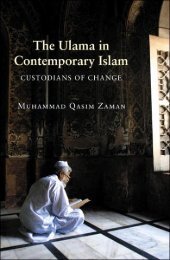The Qur'an in its historical context (pdf - Islam and Christian-Muslim ...
The Qur'an in its historical context (pdf - Islam and Christian-Muslim ...
The Qur'an in its historical context (pdf - Islam and Christian-Muslim ...
Create successful ePaper yourself
Turn your PDF publications into a flip-book with our unique Google optimized e-Paper software.
SYRIAC IN THE QUR’AN<br />
an obvious case, as is the <strong>in</strong>stance of many proper names. In-built here is a<br />
presumption of a sett<strong>in</strong>g embedded <strong>in</strong> <strong>Christian</strong>ity that has conveyed term<strong>in</strong>ology<br />
presumably not present <strong>in</strong> Arabic before, because it had no particular application<br />
<strong>and</strong> thus no need for development.<br />
But an issue rema<strong>in</strong>s here that puts much of this discussion <strong>in</strong> the same realm<br />
of speculative association as the treatises of the medieval scholars: we have little<br />
sense of a social <strong>context</strong> <strong>in</strong> which to see this l<strong>in</strong>guistic transfer happen<strong>in</strong>g <strong>and</strong><br />
thus the talk is of “Syriac <strong>Christian</strong>ity” def<strong>in</strong>ed <strong>in</strong> quite a loose manner. This is<br />
even more <strong>in</strong>convenient when one considers the Qur’an to have orig<strong>in</strong>ated <strong>in</strong> the<br />
Hijaz: the question must be, how did all this vocabulary <strong>in</strong>filtrate? We embark on<br />
a speculative path that becomes closer <strong>and</strong> closer to my attempts at generalizations<br />
for medieval theories: <strong>in</strong> medieval times, there were perhaps cultural images<br />
of water, agriculture <strong>and</strong> magic that became associated with Syriac; today we<br />
associate camel caravans <strong>and</strong> w<strong>and</strong>er<strong>in</strong>g <strong>Christian</strong>s with the cultural forces<br />
<strong>and</strong> base this on isolated hadith reports that give some credence to the speculation.<br />
A review of the assumptions of Jeffery’s Foreign Vocabulary of the<br />
Qur’an will quickly show how dated the notions of cultural <strong>in</strong>terchange are <strong>in</strong><br />
historiographical terms. 26<br />
For those like Luxenberg who wish to see an even stronger Syriac presence <strong>in</strong><br />
the text, the need to account for the mechanism by which this happened <strong>and</strong>,<br />
especially, to place that <strong>in</strong> a <strong>context</strong> of what we can postulate about the emergence<br />
of the text of the Qur’an <strong>its</strong>elf, is even more compell<strong>in</strong>g. That is, all the philological<br />
knowledge <strong>in</strong> the world is not go<strong>in</strong>g to help unless that is comb<strong>in</strong>ed with a<br />
<strong>historical</strong> picture related to the emergence of the text of the Qur’an. All these<br />
factors def<strong>in</strong>itely need to come together. François de Blois has made this po<strong>in</strong>t<br />
well <strong>in</strong> his recent article on the religious vocabulary of <strong>Christian</strong>ity <strong>and</strong> <strong>Islam</strong><br />
although he uses his evidence as an argument aga<strong>in</strong>st the “revisionist” stance<br />
without himself postulat<strong>in</strong>g a critical assessment of the history upon which he<br />
relies beyond the philological–l<strong>in</strong>guistic – other than say<strong>in</strong>g that one could<br />
“imag<strong>in</strong>e a situation where there existed, presumably <strong>in</strong> Mecca, an isolated<br />
outpost of Nazoraean ‘Jewish <strong>Christian</strong>ity.’ ” 27<br />
Only when we gaze back to the tenth century can we see any sense of real<br />
certa<strong>in</strong>ty. For medieval <strong>Muslim</strong>s, the answers to many of these matters were easy:<br />
they knew about the orig<strong>in</strong> of the Qur’an <strong>and</strong> that the presence of Syriac words <strong>in</strong><br />
the text – if one accepted that there were any to beg<strong>in</strong> with – was a part of the<br />
revelation of God’s mystery <strong>and</strong> knowledge, <strong>and</strong> this did not need to be accounted<br />
for on a human level, <strong>in</strong> the way <strong>in</strong> which we must today. And that surely is the<br />
only difference between the two approaches, the modern <strong>and</strong> the medieval:<br />
modern speculative theories or theories based upon assertion do not, <strong>in</strong> fact, take<br />
us anywhere beyond the medieval position. Faith <strong>in</strong> the <strong>historical</strong> record rivals<br />
faith <strong>in</strong> the div<strong>in</strong>e. Certa<strong>in</strong>ly I th<strong>in</strong>k that as our knowledge of early <strong>Islam</strong> <strong>and</strong> the<br />
Qur’an evolves, the place of foreign vocabulary <strong>in</strong> the text of the Qur’an will be<br />
one element – a critical one, I do th<strong>in</strong>k – <strong>in</strong> help<strong>in</strong>g us underst<strong>and</strong> the emergence<br />
of the phenomenon which we know as the Qur’an. But the attempt to specify this<br />
259



